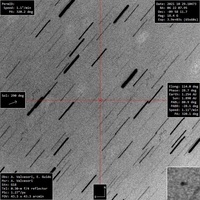COBS News archive
Comets’ heads can be green, but never their tails. After 90 years, we finally know why
What happened to C/2021 A1 (Leonard)?
New Comet P/2021 U3 (Attard-Maury)

CBET 5064 & MPEC 2021-V21, issued on 2021, November 02, announce the discovery of a new comet (magnitude ~19) by A. Maury and G. Attard on CCD images taken on October 24.3 UT with the 0.28-m f/2.2 Rowe-Ackermann Schmidt astrograph at San Pedro de Atacama, Chile in the course of the MAP (W94) survey. The new comet has been designated P/2021 U3 (Attard-Maury). This is the 4th amateur comet discovery of 2021. It is also the second comet discovered using the synthetic tracking technique (using TYCHO software).
To watch a comet form, a spacecraft could tag along for a journey toward the sun
New Comet P/2021 Q5 (ATLAS)

CBET 5029 & MPEC 2021-R98 , issued on 2021, September 06, announce the discovery of a new comet (magnitude ~17) on CCD images taken on August 29.6 UT with a 0.5-m f/2 Schmidt reflector at Haleakala, Hawaii, in the course of the "Asteroid Terrestrial-Impact Last Alert System" (ATLAS) search program. The new comet has been designated P/2021 Q5 (ATLAS).
New Comet C/2021 Q4 (Fuls)

New Comet C/2021 P4 (ATLAS)

Interstellar comets like Borisov may not be all that rare
New Comet C/2021 O3 (PANSTARRS)

New Comet C/2021 N3 (PANSTARRS)

CBET 5003 & MPEC 2021-O39, issued on 2021, July 22, announce the discovery of a new comet (magnitude ~20.5) on CCD images taken on July 13.5 UT with the Pan-STARRS1 1.8-m Ritchey-Chretien reflector at Haleakala (numerous pre-discovery observations going back an additional month were later identified). The new comet has been designated C/2021 N3 (PANSTARRS).
New Comet P/2021 N2 (Fuls)

CBET 5000 & MPEC 2021-N137, issued on 2021, July 15, announce the discovery of a new comet (magnitude ~18.3) on CCD images taken on July 09.4 UT with the Catalina Sky Survey's 0.68-m Schmidt reflector (pre-discovery Catalina observations from June 27 were identified later). The new comet has been designated P/2021 N2 (Fuls).
New Comet C/2021 K2 (MASTER)

CBET 4975 & MPEC 2021-L89, issued on 2021, June 09, announce the discovery of a new comet (magnitude ~19.0) on CCD images taken on May 23.0 UT with the "Mobile Astronomical System of the Telescope-Robots" (MASTER) auto-detection system (double 0.40-m f/2.5 reflector) at the South African Astronomical Observatory. The object was reported by MASTER as a new NEO candidate and has been found to show cometary activity by CCD astrometrists elsewhere. The new comet has been designated C/2021 K2 (MASTER).
New Comet C/2021 J1 (Maury-Attard)

CBET 4972 & MPEC 2021-L11, issued on 2021, June 02, announce the discovery of a new comet (magnitude ~19.0) on CCD images taken by A. Maury and G. Attard on May 09.3 UT with the 0.28-m f/2.2 Rowe-Ackermann Schmidt astrograph at San Pedro de Atacama, Chile in the course of the MAP (W94) survey. The new comet has been designated C/2021 J1 (Maury-Attard). This is the first amateur comet discovery of 2021. It is also the first comet ever discovered using the synthetic tracking technique (using TYCHO software).
New Comet C/2021 K1 (ATLAS)

CBET 4968 & MPEC 2021-K89, issued on 2021, May 27, announce the discovery of a new comet (magnitude ~17.0) on CCD images taken on May 14.5 UT with the 0.5-m reflector + CCD in the course of the ATLAS-HKO (T05) survey. The object was originally found by Peter Veres of Minor Planet Center (MPC) as unusually bright among the MPC's isolated tracklet file (ITF) and linked to the detections from May 22 (F51) and May 14 (T08). A review of the ATLAS images revealed the cometary nature of this object.
New Reference catalog keys
New Comet C/2021 E3 (ZTF)

CBET xxxx & MPEC 2021-J71 , issued on 2021, May 06, announce the discovery of an apparently asteroidal object (magnitude ~19.5) on CCD images taken on March 09.5 UT with the 1.2-m Schmidt telescope at Palomar in the course of the "Zwicky Transient Facility" (ZTF) search program. This object has been found to show cometary appearance by CCD astrometrists elsewhere. The new comet has been designated C/2021 E3 (ZTF).
Exploring comet thermal history: Burnt-out comet covered with talcum powder
New Comet C/2019 U5 (PANSTARRS)

First interstellar comet may be the most pristine ever found
New Comet C/2020 F7 (Lemmon)
